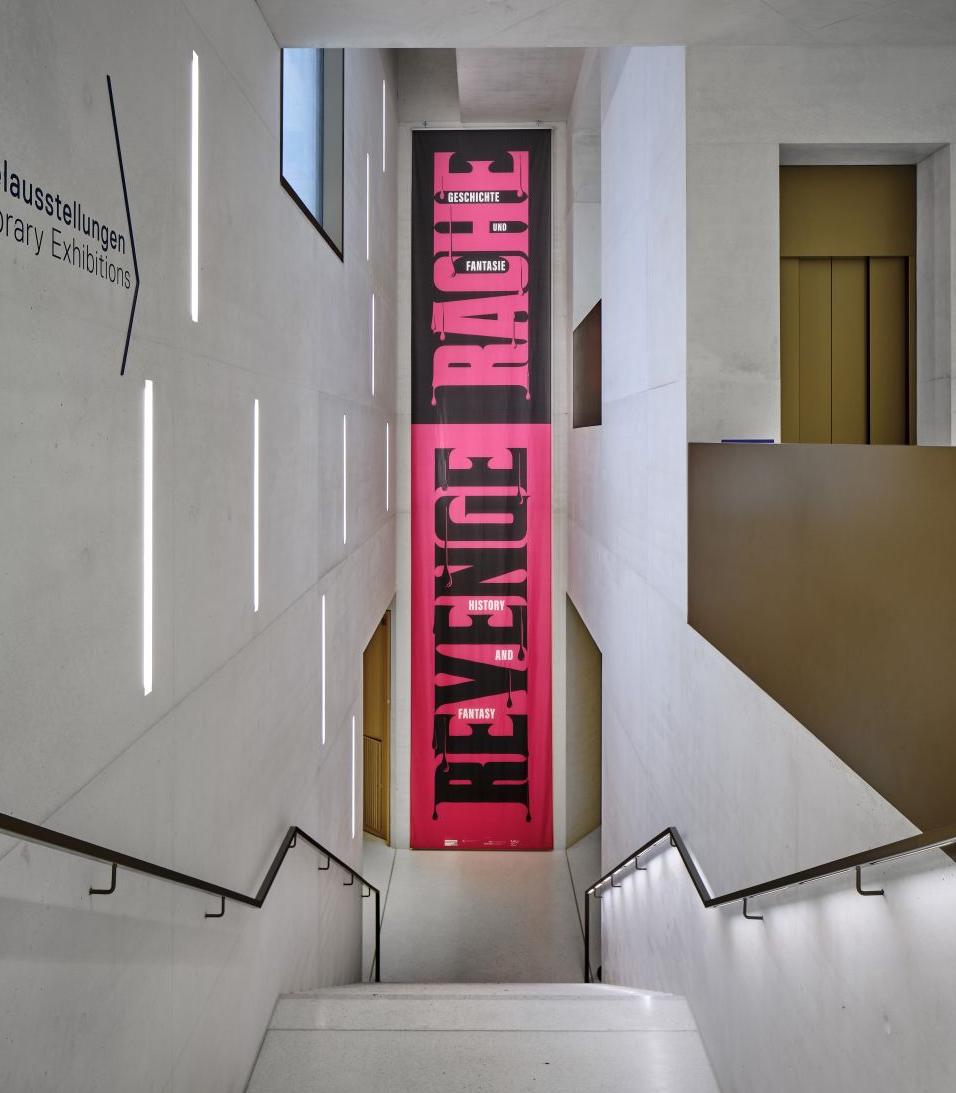For our exhibition "Revenge. History and Fantasy" we have developed special dialogue labels. On them, we discuss essential questions that came up throughout the development of the exhibition.

(German version of the blog post)
You will find the dialogue labels at various points in the exhibition. They are based on lengthy conversations between our director Mirjam Wenzel and the lyricist Max Czollek, who gave us the ideas for the exhibition and also co-curated it. Even if the thoughts cannot always be assigned directly to specific persons, they nevertheless reflect the discussion that accompanied the two-year development phase of the exhibition.
The first exhibition on the theme of revenge in Jewish cultural history
Curator: Why is it that the cultural history of Jewish vengeance has never been treated in an exhibition before?
Director: It’s a highly ambivalent topic, and currently no one is very eager to deal with stories and feelings that are so mixed.
Curator: Personally, though, I think the topic has been in the air ever since Quentin Tarantino’s Inglourious Basterds (2009).
Director: That’s right, especially over the last two years, with the Amazon series Hunters and the movie Plan A by Doron and Yoav Paz.
Curator: And a whole range of books on Jewish acts of revenge against Nazis. Are those historical acts of revenge the central starting point of our exhibition?
Director: Yes and no. What we’re presenting is really more a history of imaginary acts of revenge – acts Jews have dreamed about, written about or captured in art, but which have also been ascribed to them. So it’s a history of feelings and violent fantasies.
Curator: Or, in fact, a history of the question how justice can be restored.
Director: Would you say this also applies to our motivation for putting together this exhibition?
Curator: Yes, I would. After all, we want to do more than just debunk the anti-Semitic image of the “vengeful Jew.” We also want to take seriously the feelings and narratives that gave rise to the experience of violence that so many Jews have suffered over the centuries.
Fantasies of powerless
Director: One of the most powerful notions in Christianity is the claim that the “God of vengeance” of the so-called Old Testament was replaced by the “God of atonement” in the New Testament. Isn’t there the danger that this exhibition could confirm such an anti-Jewish distinction?
Curator: It’s one of the most insidious and perverse dynamics of discrimination that perpetrators of violence often blame their victims for defending themselves.
Director: But how does that relate to this exhibition?
Curator: Because the things we’ve identified and portrayed as revenge are largely a fictional response to the dominant Christian culture, which persecuted and killed Jews.
Director: So you’d say that fantasizing is a tool of the powerless, and the idea of atonement is a gesture of the powerful?
Curator: Yes, ultimately the Christian idea of an atoning God conceals the asymmetrical power relations of the history of anti-Jewish violence.
Empowerment
Director: Do you think a Jewish perspective on revenge narratives might be to regard them as a form of empowerment?
Curator: Yes, lots of Jewish festivals tell a story along the lines of “They tried to kill us, but they failed, so let’s have a feast.”
Director: Here’s to life!
Curator: Exactly, but there’s more to it. By celebrating these festivals, the living also see themselves as part of a community of survivors who remember that there are still scores to settle.
Director: So does this mean revenge fantasies are stories that reverse and rectify asymmetrical relationships of power and violence?
Curator: Thousands of years of violence are bound to leave traces. And the result is not just fear, but also the hope that the others will finally get what they deserve.
Resilience
Director: These days we spend a lot of time talking about the need for a resilient democracy. Is there a link between Jewish stories of revenge and the resilience and constitutional shape of our democracy?
Curator: Yes and no. To understand the current relevance of revenge fantasies, we need to drill down a bit more deeply.
Director: Meaning?
Curator: On the one hand, there’s a link between revenge fantasies and life in a pluralistic democracy.
Director: Well, acts of revenge aren’t really all that helpful for a pluralistic society.
Curator: That’s right, but we’re talking about revenge fantasies here, i.e. narratives that preserve an idea that people haven’t just become more similar to one another over the centuries; instead, they’ve also experienced different narratives of violence, and these narratives continue to play a role today.
Jewish Humanity
Director: Why are we actually holding this kind of exhibition right now?
Curator: I think there are lots of reasons. One of them is that combating anti-Semitism must include fighting for the recognition of a Jewish sense of humanity, and this includes the fact that when people experience violence, that violence always causes resistance.
Director: Another reason is that one of the jobs of a Jewish museum is to tell stories that haven’t been told yet.
Curator: And there’s another reason, associated with the specific situation of Jews in Germany after 1945. The way in which German society has related to its Jewish community has been largely marked by a focus on the victim status of that community and on reconciliation.
Director: Yet Jews were also active protagonists who resisted their extermination. And this perspective was extremely important to Arno Lustiger, for instance, whose estate is preserved here at the museum.
Curator: Revenge and grief are both very much part of Jewish self-empowerment. Our shared humanity comes from the heartbreaking fact that history happened the way it did – and from the attempt to organize the present in a way that stops this history from repeating itself.






Noch keine Kommentare. Diskutieren Sie mit.
Ihr Kommentar